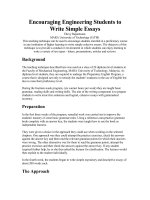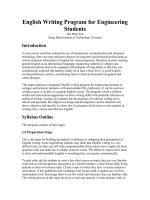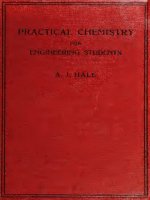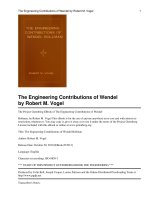Engineering curves
Bạn đang xem bản rút gọn của tài liệu. Xem và tải ngay bản đầy đủ của tài liệu tại đây (418.33 KB, 32 trang )
INVOLUTE CYCLOID SPIRAL HELIX
ENGINEERING CURVES
Part-II
(Point undergoing two types of displacements)
1. Involute of a circle
a)String Length = πD
b)String Length > πD
c)String Length < πD
2. Pole having Composite
shape.
3. Rod Rolling over
a Semicircular Pole.
1. General Cycloid
2. Trochoid
( superior)
3. Trochoid
( Inferior)
4. Epi-Cycloid
5. Hypo-Cycloid
1. Spiral of
One Convolution.
2. Spiral of
Two Convolutions.
1. On Cylinder
2. On a Cone
Methods of Drawing
Tangents & Normals
To These Curves.
AND
CYCLOID:
IT IS A LOCUS OF A POINT ON THE
PERIPHERY OF A CIRCLE WHICH
ROLLS ON A STRAIGHT LINE PATH.
INVOLUTE:
IT IS A LOCUS OF A FREE END OF A STRING
WHEN IT IS WOUND ROUND A CIRCULAR POLE
SPIRAL:
IT IS A CURVE GENERATED BY A POINT
WHICH REVOLVES AROUND A FIXED POINT
AND AT THE SAME MOVES TOWARDS IT.
HELIX:
IT IS A CURVE GENERATED BY A POINT WHICH
MOVES AROUND THE SURFACE OF A RIGHT CIRCULAR
CYLINDER / CONE AND AT THE SAME TIME ADVANCES IN AXIAL DIRECTION
AT A SPEED BEARING A CONSTANT RATIO TO THE SPPED OF ROTATION.
( for problems refer topic Development of surfaces)
DEFINITIONS
SUPERIORTROCHOID:
IF THE POINT IN THE DEFINATION
OF CYCLOID IS OUTSIDE THE CIRCLE
INFERIOR TROCHOID.:
IF IT IS INSIDE THE CIRCLE
EPI-CYCLOID
IF THE CIRCLE IS ROLLING ON
ANOTHER CIRCLE FROM OUTSIDE
HYPO-CYCLOID.
IF THE CIRCLE IS ROLLING FROM
INSIDE THE OTHER CIRCLE,
INVOLUTE OF A CIRCLE
Problem no 17: Draw Involute of a circle.
String length is equal to the circumference of circle.
1 2
3 4
5 6
7 8
P
P
8
1
2
3
4
5
6
7
8
P
3
3
t
o
p
P
4
4 to p
P
5
5
t
o
p
P
7
7
t
o
p
P
6
6
t
o
p
P
2
2
t
o
p
P
1
1
t
o
p
π
D
A
Solution Steps:
1) Point or end P of string AP is
exactly πD distance away from A.
Means if this string is wound round
the circle, it will completely cover
given circle. B will meet A after
winding.
2) Divide πD (AP) distance into 8
number of equal parts.
3) Divide circle also into 8 number
of equal parts.
4) Name after A, 1, 2, 3, 4, etc. up
to 8 on πD line AP as well as on
circle (in anticlockwise direction).
5) To radius C-1, C-2, C-3 up to C-8
draw tangents (from 1,2,3,4,etc to
circle).
6) Take distance 1 to P in compass
and mark it on tangent from point 1
on circle (means one division less
than distance AP).
7) Name this point P1
8) Take 2-B distance in compass
and mark it on the tangent from
point 2. Name it point P2.
9) Similarly take 3 to P, 4 to P, 5 to
P up to 7 to P distance in compass
and mark on respective tangents
and locate P3, P4, P5 up to P8 (i.e.
A) points and join them in smooth
curve it is an INVOLUTE of a given
circle.
INVOLUTE OF A CIRCLE
String length MORE than πD
1 2
3 4
5 6
7 8
P
1
2
3
4
5
6
7
8
P
3
3
t
o
p
P
4
4 to p
P
5
5
t
o
p
P
7
7
t
o
p
P
6
6
t
o
p
P
2
2
t
o
p
P
1
1
t
o
p
165 mm
(more than πD)
πD
p
8
Solution Steps:
In this case string length is more
than Π D.
But remember!
Whatever may be the length of
string, mark Π D distance
horizontal i.e.along the string
and divide it in 8 number of
equal parts, and not any other
distance. Rest all steps are same
as previous INVOLUTE. Draw
the curve completely.
Problem 18: Draw Involute of a circle.
String length is MORE than the circumference of circle.
1 2
3 4
5 6
7 8
P
1
2
3
4
5
6
7
8
P
3
3
t
o
p
P
4
4 to p
P
5
5
t
o
p
P
7
7
t
o
p
P
6
6
t
o
p
P
2
2
t
o
p
P
1
1
t
o
p
150 mm
(Less than πD)
πD
INVOLUTE OF A CIRCLE
String length LESS than πD
Problem 19: Draw Involute of a circle.
String length is LESS than the circumference of circle.
Solution Steps:
In this case string length is Less
than Π D.
But remember!
Whatever may be the length of
string, mark Π D distance
horizontal i.e.along the string
and divide it in 8 number of
equal parts, and not any other
distance. Rest all steps are same
as previous INVOLUTE. Draw
the curve completely.
1
2
3
4
5
6
1
2
3
4
5
6
A
P
πD/2
P
1
1 to P
P
2
2
t
o
P
P
3
3 to P
P
4
4
t
o
P
P
A
t
o
P
P
5
5
t
o
P
P
6
6
t
o
P
INVOLUTE
OF
COMPOSIT SHAPED POLE
PROBLEM 20 : A POLE IS OF A SHAPE OF HALF HEXABON AND SEMICIRCLE.
ASTRING IS TO BE WOUND HAVING LENGTH EQUAL TO THE POLE PERIMETER
DRAW PATH OF FREE END P OF STRING WHEN WOUND COMPLETELY.
(Take hex 30 mm sides and semicircle of 60 mm diameter.)
SOLUTION STEPS:
Draw pole shape as per
dimensions.
Divide semicircle in 4
parts and name those
along with corners of
hexagon.
Calculate perimeter
length.
Show it as string AP.
On this line mark 30mm
from A
Mark and name it 1
Mark πD/2 distance on it
from 1
And dividing it in 4 parts
name 2,3,4,5.
Mark point 6 on line 30
mm from 5
Now draw tangents from
all points of pole
and proper lengths as
done in all previous
involute’s problems and
complete the curve.
1
2
3
4
πD
1
2
3
4
A
B
A
1
B
1
A
2
B
2
A
3
B
3
A
4
B
4
PROBLEM 21 : Rod AB 85 mm long rolls
over a semicircular pole without slipping
from it’s initially vertical position till it
becomes up-side-down vertical.
Draw locus of both ends A & B.
Solution Steps?
If you have studied previous problems
properly, you can surely solve this also.
Simply remember that this being a rod,
it will roll over the surface of pole.
Means when one end is approaching,
other end will move away from poll.
OBSERVE ILLUSTRATION CAREFULLY!
P
C
1
C
2
C
3
C
4
C
5
C
6
C
7
C
8
C
9
C
10
C
11
C
12
p
1
p
2
p
3
p
4
p
5
p
6
p
7
p
8
πD
CYCLOID
PROBLEM 22: DRAW LOCUS OF A POINT ON THE PERIPHERY OF A CIRCLE
WHICH ROLLS ON STRAIGHT LINE PATH. Take Circle diameter as 50 mm
Solution Steps:
1) From center C draw a horizontal line equal to πD distance.
2) Divide πD distance into 12 number of equal parts and name them C1, C2, C3__ etc.
3) Divide the circle also into 12 number of equal parts and in clock wise direction, after P name 1, 2, 3 up to 12.
4) From all these points on circle draw horizontal lines. (parallel to locus of C)
5) With a fixed distance C-P in compass, C1 as center, mark a point on horizontal line from 1. Name it P.
6) Repeat this procedure from C2, C3, C4 upto C12 as centers. Mark points P2, P3, P4, P5 up to P8 on the
horizontal lines drawn from 1,2, 3, 4, 5, 6, 7 respectively.
7) Join all these points by curve. It is Cycloid.
p
9
p
10
p
11
p
12
1
2
3
5
4
6
7
8
9
10
11
12
C
1
C
2
C
3
C
4
C
5
C
6
C
7
C
8
p
1
p
2
p
3
p
4
p
5
p
6
p
7
p
8
1
2
3
4
5
6
7
C
πD
SUPERIOR TROCHOID
P
PROBLEM 23: DRAW LOCUS OF A POINT , 5 MM AWAY FROM THE PERIPHERY OF A
CIRCLE WHICH ROLLS ON STRAIGHT LINE PATH. Take Circle diameter as 50 mm
Solution Steps:
1) Draw circle of given diameter and draw a horizontal line from it’s center C of length Π D and divide it
in 8 number of equal parts and name them C1, C2, C3, up to C8.
2) Draw circle by CP radius, as in this case CP is larger than radius of circle.
3) Now repeat steps as per the previous problem of cycloid, by dividing this new circle into 8 number of
equal parts and drawing lines from all these points parallel to locus of C and taking CP radius wit
different positions of C as centers, cut these lines and get different positions of P and join
4) This curve is called Superior Trochoid.
P
C
1
C
2
C
3
C
4
C
5
C
6
C
7
C
8
p
1
p
2
p
3
p
4
p
5
p
6
p
7
p
8
1
2
3
4
5
6
7
C
πD
INFERIOR TROCHOID
PROBLEM 24: DRAW LOCUS OF A POINT , 5 MM INSIDE THE PERIPHERY OF A
CIRCLE WHICH ROLLS ON STRAIGHT LINE PATH. Take Circle diameter as 50 mm
Solution Steps:
1) Draw circle of given diameter and draw a horizontal line from it’s center C of length Π D and divide it
in 8 number of equal parts and name them C1, C2, C3, up to C8.
2) Draw circle by CP radius, as in this case CP is SHORTER than radius of circle.
3) Now repeat steps as per the previous problem of cycloid, by dividing this new circle into 8 number
of equal parts and drawing lines from all these points parallel to locus of C and taking CP radius
with different positions of C as centers, cut these lines and get different positions of P and join
those in curvature.
4) This curve is called Inferior Trochoid.
C
C
1
C
2
C
3
C
4
C
5
C
8
C
6
C
7
EPI CYCLOID :
P
O
R
r = CP
+
r
R
360
0
=
1
2
3
4
5
6
7
Generating/
Rolling Circle
Directing Circle
PROBLEM 25: DRAW LOCUS OF A POINT ON THE PERIPHERY OF A CIRCLE
WHICH ROLLS ON A CURVED PATH. Take diameter of rolling Circle 50 mm
And radius of directing circle i.e. curved path, 75 mm.
Solution Steps:
1) When smaller circle will roll on
larger circle for one revolution it will
cover Π D distance on arc and it will be
decided by included arc angle θ.
2) Calculate θ by formula θ = (r/R) x
3600.
3) Construct angle θ with radius OC
and draw an arc by taking O as center
OC as radius and form sector of angle
θ.
4) Divide this sector into 8 number of
equal angular parts. And from C
onward name them C1, C2, C3 up to
C8.
5) Divide smaller circle (Generating
circle) also in 8 number of equal parts.
And next to P in clockwise direction
name those 1, 2, 3, up to 8.
6) With O as center, O-1 as radius
draw an arc in the sector. Take O-2, O-
3, O-4, O-5 up to O-8 distances with
center O, draw all concentric arcs in
sector. Take fixed distance C-P in
compass, C1 center, cut arc of 1 at P1.
Repeat procedure and locate P2, P3,
P4, P5 unto P8 (as in cycloid) and join
them by smooth curve. This is EPI –
CYCLOID.
O
P
OP=Radius of directing circle=75mm
C
PC=Radius of generating circle=25mm
θ
θ=r/R X360º= 25/75 X360º=120º
1
2
3
4
5
6
7
8
9
10
11
12
1’
2’
3’
4’
5’
6’
7’
8’
9’
10’
11’
12’
c
1
c
2
c
3
c
4
c
5
c
6
c
7
c
8
c
9
c
10
c
11
c
12
HYPO CYCLOID
C
P
1
P
2
P
3
P
4
P
5
P
6
P
7
P
8
P
1
2
3
6
5
7
4
C
1
C
2
C
3
C
4
C
5
C
6
C
7
C
8
O
OC = R ( Radius of Directing Circle)
CP = r (Radius of Generating Circle)
+
r
R
360
0
=
PROBLEM 26: DRAW LOCUS OF A POINT ON THE PERIPHERY OF A CIRCLE
WHICH ROLLS FROM THE INSIDE OF A CURVED PATH. Take diameter of
rolling circle 50 mm and radius of directing circle (curved path) 75 mm.
Solution Steps:
1) Smaller circle is rolling
here, inside the larger
circle. It has to rotate
anticlockwise to move
ahead.
2) Same steps should be
taken as in case of EPI –
CYCLOID. Only change is
in numbering direction of
8 number of equal parts
on the smaller circle.
3) From next to P in
anticlockwise direction,
name 1,2,3,4,5,6,7,8.
4)
Further all steps are
that of epi – cycloid. This
is called
HYPO – CYCLOID.
O
P
OP=Radius of directing circle=75mm
C
PC=Radius of generating circle=25mm
θ
θ=r/R X360º= 25/75 X360º=120º
1
2
3
4
5
6
7
8
9
10
11
12
c
2
c
1
c
3
c
4
c
5
c
6
c
7
c
8
c
9
c
10
c
11
c
12
1’
2’
3’
4’
5’
6’
7’
8’
9’
10’
11’
12’
7 6 5 4 3 2 1
P
1
2
3
4
5
6
7
P
2
P
6
P
1
P
3
P
5
P
7
P
4
O
SPIRAL
Problem 27: Draw a spiral of one convolution. Take distance PO 40 mm.
Solution Steps
1. With PO radius draw a circle
and divide it in EIGHT parts.
Name those 1,2,3,4, etc. up to 8
2 .Similarly divided line PO also in
EIGHT parts and name those
1,2,3, as shown.
3. Take o-1 distance from op line
and draw an arc up to O1 radius
vector. Name the point P
1
4. Similarly mark points P
2
, P
3
, P
4
up to P
8
And join those in a smooth curve.
It is a SPIRAL of one convolution.
IMPORTANT APPROACH FOR CONSTRUCTION!
FIND TOTAL ANGULAR AND TOTAL LINEAR DISPLACEMENT
AND DIVIDE BOTH IN TO SAME NUMBER OF EQUAL PARTS.
16 13 10 8 7 6 5 4 3 2 1 P
1,9
2,10
3,11
4,12
5,13
6,14
7,15
8,16
P
1
P
2
P
3
P
4
P
5
P
6
P
7
P
8
P
9
P
10
P
11
P
12
P
13
P
14
P
15
SPIRAL
of
two convolutions
Problem 28
Point P is 80 mm from point O. It starts moving towards O and reaches it in two
revolutions around.it Draw locus of point P (To draw a Spiral of TWO convolutions).
IMPORTANT APPROACH FOR CONSTRUCTION!
FIND TOTAL ANGULAR AND TOTAL LINEAR DISPLACEMENT
AND DIVIDE BOTH IN TO SAME NUMBER OF EQUAL PARTS.
SOLUTION STEPS:
Total angular displacement here
is two revolutions And
Total Linear displacement here
is distance PO.
Just divide both in same parts i.e.
Circle in EIGHT parts.
( means total angular displacement
in SIXTEEN parts)
Divide PO also in SIXTEEN parts.
Rest steps are similar to the previous
problem.
1
2
3
4
5
6
7
8
P
P
1
P
P
2
P
3
P
4
P
5
P
6
P
7
P
8
1
2
3
4
5
6
7
HELIX
(UPON A CYLINDER)
PROBLEM: Draw a helix of one convolution, upon a cylinder.
Given 80 mm pitch and 50 mm diameter of a cylinder.
(The axial advance during one complete revolution is called
The pitch of the helix)
SOLUTION:
Draw projections of a cylinder.
Divide circle and axis in to same no. of equal parts. ( 8 )
Name those as shown.
Mark initial position of point ‘P’
Mark various positions of P as shown in animation.
Join all points by smooth possible curve.
Make upper half dotted, as it is going behind the solid
and hence will not be seen from front side.
P
1
2
3
4
5
6
7
1
2
3
4
5
6
7
8
P
P
1
P
2
P
3
P
4
P
5
P
6
P
7
P
8
P
1
P
2
P
3
P
4
P
5
P
6
P
7
P
8
X
Y
HELIX
(UPON A CONE)
PROBLEM: Draw a helix of one convolution, upon a cone,
diameter of base 70 mm, axis 90 mm and 90 mm pitch.
(The axial advance during one complete revolution is called
The pitch of the helix)
SOLUTION:
Draw projections of a cone
Divide circle and axis in to same no. of equal parts. ( 8 )
Name those as shown.
Mark initial position of point ‘P’
Mark various positions of P as shown in animation.
Join all points by smooth possible curve.
Make upper half dotted, as it is going behind the solid
and hence will not be seen from front side.
T
a
n
g
e
n
t
N
o
r
m
a
l
Q
Involute
Method of Drawing
Tangent & Normal
STEPS:
DRAW INVOLUTE AS USUAL.
MARK POINT Q ON IT AS DIRECTED.
JOIN Q TO THE CENTER OF CIRCLE C.
CONSIDERING CQ DIAMETER, DRAW
A SEMICIRCLE AS SHOWN.
MARK POINT OF INTERSECTION OF
THIS SEMICIRCLE AND POLE CIRCLE
AND JOIN IT TO Q.
THIS WILL BE NORMAL TO INVOLUTE.
DRAW A LINE AT RIGHT ANGLE TO
THIS LINE FROM Q.
IT WILL BE TANGENT TO INVOLUTE.
1 2
3 4
5 6
7 8
P
P
8
1
2
3
4
5
6
7
8
INVOLUTE OF A CIRCLE
π
D
C
Q
N
N
o
r
m
a
l
T
a
n
g
e
n
t
CYCLOID
Method of Drawing
Tangent & Normal
STEPS:
DRAW CYCLOID AS USUAL.
MARK POINT Q ON IT AS DIRECTED.
WITH CP DISTANCE, FROM Q. CUT THE
POINT ON LOCUS OF C AND JOIN IT TO Q.
FROM THIS POINT DROP A PERPENDICULAR
ON GROUND LINE AND NAME IT N
JOIN N WITH Q.THIS WILL BE NORMAL TO
CYCLOID.
DRAW A LINE AT RIGHT ANGLE TO
THIS LINE FROM Q.
IT WILL BE TANGENT TO CYCLOID.
P
C
1
C
2
C
3
C
4
C
5
C
6
C
7
C
8
πD
CYCLOID
C
C
P
7 6 5 4 3 2 1
P
1
2
3
4
5
6
7
P
2
P
6
P
1
P
3
P
5
P
7
P
4
O
SPIRAL (ONE CONVOLUSION.)
N
o
r
m
a
l
T
a
n
g
e
n
t
Q
Spiral.
Method of Drawing
Tangent & Normal
Constant of the Curve =
Difference in length of any radius vectors
Angle between the corresponding
radius vector in radian.
OP – OP
2
π/2
OP – OP
2
1.57
= 3.185 m.m.
=
=
STEPS:
*DRAW SPIRAL AS USUAL.
DRAW A SMALL CIRCLE OF RADIUS EQUAL TO THE
CONSTANT OF CURVE CALCULATED ABOVE.
* LOCATE POINT Q AS DISCRIBED IN PROBLEM AND
THROUGH IT DRAW A TANGENTTO THIS SMALLER
CIRCLE.THIS IS A NORMAL TO THE SPIRAL.
*DRAW A LINE AT RIGHT ANGLE
*TO THIS LINE FROM Q.
IT WILL BE TANGENT TO CYCLOID.
LOCUS
It is a path traced out by a point moving in a plane,
in a particular manner, for one cycle of operation.
The cases are classified in THREE categories for easy understanding.
A} Basic Locus Cases.
B} Oscillating Link……
C} Rotating Link………
Basic Locus Cases:
Here some geometrical objects like point, line, circle will be described with there relative
Positions. Then one point will be allowed to move in a plane maintaining specific relation
with above objects. And studying situation carefully you will be asked to draw it’s locus.
Oscillating & Rotating Link:
Here a link oscillating from one end or rotating around it’s center will be described.
Then a point will be allowed to slide along the link in specific manner. And now studying
the situation carefully you will be asked to draw it’s locus.
STUDY TEN CASES GIVEN ON NEXT PAGES
A
B
p
4 3 2 1
F
1 2 3 4
SOLUTION STEPS:
1.Locate center of line, perpendicular to
AB from point F. This will be initial
point P.
2.Mark 5 mm distance to its right side,
name those points 1,2,3,4 and from those
draw lines parallel to AB.
3.Mark 5 mm distance to its left of P and
name it 1.
4.Take F-1 distance as radius and F as
center draw an arc
cutting first parallel line to AB. Name
upper point P
1
and lower point P
2
.
5.Similarly repeat this process by taking
again 5mm to right and left and locate
P
3
P
4
.
6.Join all these points in smooth curve.
It will be the locus of P equidistance
from line AB and fixed point F.
P
1
P
2
P
3
P
4
P
5
P
6
P
7
P
8
PROBLEM 1.: Point F is 50 mm from a vertical straight line AB.
Draw locus of point P, moving in a plane such that
it always remains equidistant from point F and line AB.
Basic Locus Cases:
A
B
p
4 3 2 1
1 2 3 4
P
1
P
2
P
3
P
4
P
5
P
6
P
7
P
8
C
SOLUTION STEPS:
1.Locate center of line, perpendicular to
AB from the periphery of circle. This
will be initial point P.
2.Mark 5 mm distance to its right side,
name those points 1,2,3,4 and from those
draw lines parallel to AB.
3.Mark 5 mm distance to its left of P and
name it 1,2,3,4.
4.Take C-1 distance as radius and C as
center draw an arc cutting first parallel
line to AB. Name upper point P
1
and
lower point P
2
.
5.Similarly repeat this process by taking
again 5mm to right and left and locate
P
3
P
4
.
6.Join all these points in smooth curve.
It will be the locus of P equidistance
from line AB and given circle.
50 D
75 mm
PROBLEM 2 :
A circle of 50 mm diameter has it’s center 75 mm from a vertical
line AB Draw locus of point P, moving in a plane such that
it always remains equidistant from given circle and line AB.
Basic Locus Cases:
95 mm
30 D
60 D
p
4 3 2 1
1 2 3 4
C
2
C
1
P
1
P
2
P
3
P
4
P
5
P
6
P
7
P
8
PROBLEM 3 :
Center of a circle of 30 mm diameter is 90 mm away from center of another circle of 60 mm diameter.
Draw locus of point P, moving in a plane such that it always remains equidistant from given two circles.
SOLUTION STEPS:
1.Locate center of line,joining two
centers but part in between periphery
of two circles.Name it P. This will be
initial point P.
2.Mark 5 mm distance to its right
side, name those points 1,2,3,4 and
from those draw arcs from C
1
As center.
3. Mark 5 mm distance to its right
side, name those points 1,2,3,4 and
from those draw arcs from C
2
As
center.
4.Mark various positions of P as per
previous problems and name those
similarly.
5.Join all these points in smooth
curve.
It will be the locus of P
equidistance from given two
circles.
Basic Locus Cases:









